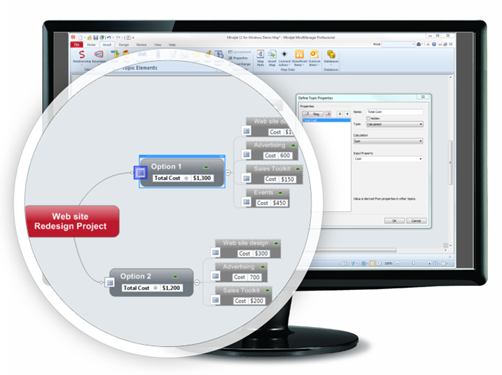Now all one price: Mindjet's desktop mind-mapping software, plus all associated Web and mobile tools for sharing and organizing ideas, plans, and budgets, and collaborating to get work done.


Enterprise Social Networks: Must-Have Features Guide
Enterprise Social Networks: Must-Have Features Guide (click image for larger view and for slideshow)
After spending the last year extending the collaborative reach of its productivity software for generating and organizing ideas and plans, Mindjet has decided to simplify things again.
Rather than selling several products, Mindjet will sell its entire suite for one price and let users take advantage of whatever components they need. In other words, those who need MindManager, the company's traditional desktop mind-mapping tool, will be able to download it as part of the package, while some might interact with the system only through its Web user interface or a mobile client, and others might use all modes of interaction.
About a year ago, Mindjet introduced a cloud application for collaboration around mind maps, and it also acquired Cohuman, a cloud-based tool for collaboration and task management. Since then, the company has consolidated those products into a Mindject Connect, which it described as a "single platform for both envisioning plans and acting on them." However, it still had other variations, such as Mindjet Connect SP for integration with SharePoint, as well as its desktop tools and apps for iPhone, iPad, and Android.
[ Are your enterprise applications learning the art of conversation? Read Apps Need Collaboration At Core. ]
"Now we have one single product, and that product is Mindjet," chief products officer Blaine Mathieu said in an interview. "Anyone who buys or subscribes to Mindjet gets all that capability, all that value, in one shot." The subscription price is $30/user per month, or $360 per year, with price breaks for larger enterprises. Most existing customers will pay the same or less than they would have paid for upgrades under the prior pricing scheme, he said.
Mind-mapping software allows people to map out plans with branching alternatives and hierarchical relationships, much as they would on a whiteboard, except that in the process it also creates a digital model of the plan or brainstorming session. In the latest release, Mindjet has added the ability to include spreadsheet-like calculations in the nodes of a map. For example, you can attach costs to each of the tasks to be performed in each phase of a project plan, and the sums will automatically recalculate as you move tasks from one phase to another.

Mindjet maps for project planning and budgeting can now include calculated fields.
When a project plan composed on the desktop is synchronized with the Mindjet Connect collaboration environment, the associated tasks are also synchronized. The updated tasks show up in the Web-based version of the mind-mapping tool, but also in Mindjet Connect Action, the component derived from the Cohuman acquisition that presents tasks in something more like the activity feed format associated with social software.
"This is a great collaboration tool," said Chris Silva, an analyst at the Altimeter Group who focuses on workplace connectivity and mobile technologies. "It can be a lot of tool and a lot of horsepower for simple tasks, but on the other hand, it can be a simple tool for very complex tasks." Mind mapping is a mode of planning that is foreign to many people, and not everyone takes to it, Silva said. That's one reason the task synchronization Mindjet is introducing is important: "You can have the engineer's view of it, or the community manager's view," he explained.
In addition, Silva said, the rise of touchscreen user interfaces on devices like the iPad might encourage adoption of the "tactile task management" Mindjet makes possible.
In switching to a single-suite pricing model, Mindjet is trying to encourage people to remember a single brand name, rather than the names of multiple individual products, according to Silva--in the way that people talk about using Evernote without making fine distinctions between editions. There is also a practical benefit for organizations introducing the technology, because it allows people to adopt the tools at their own pace. "Trying to get people to use Mindjet, whether they use one feature or a hundred features, is the only way to foster viral popularity," Silva said.
One organization that's adopting Mindjet as a core planning and collaboration tool is Education Development Center, a not-for-profit organization, primarily funded by the federal government, that promotes educational programs worldwide.
"At any given time, we have about 250 active projects," said Robert Spielvogel, chief technology officer and vice president for research, evaluation, and policy. Most of those projects are not big enough to support having someone in charge of managing and updating a plan in a tool like Microsoft Project. As a result, project managers had been left to sink or swim on their own.
Although many EDC employees were already using MindManager as a personal productivity tool, until recently it was not a technology the organization officially promoted, Spielvogel said. Last November, he got a cold call from a Mindjet salesperson who had noticed that EDC already had about 220 licenses and wanted to know if EDC would like to try the new, more collaborative product line. The timing was good because EDC had just gone through a long-range strategic technology planning process over the course of a year and a half, which included an outside audit that pointed out the weaknesses in the organization's technology infrastructure.
One of the priorities that emerged was a need for better online collaboration, Spielvogel said. "We have project offices and field offices all around the world, and in almost any meeting we have people joining in from outside our offices. So we realized we needed to get a lot better as an organization at supporting virtual team collaboration."
Also, EDC recognized the need to be better organized about project management, and a collaborative environment would provide ways of capturing lessons learned, probably more effectively than would be achieved with traditional knowledge management methods.
After a pilot deployment that lasted from January to May, EDC "decided to go all-in on Mindjet," Spielvogel said. The transition probably went more smoothly because EDC already had employees who were familiar with mind mapping and could tutor their peers, but the nature of the medium has its own virtues. "The visual nature of the product greatly lowered the learning curve," he said. "It lets you see the forest and the trees at the same time."
Also, in the context of international collaboration, where not everyone on the team is a native speaker of English, visual project plans can help close some gaps in understanding, Spielvogel said.
EDC is about halfway through its rollout of Mindjet, in which every employee will get a copy of the desktop tool as well as access to the Web components. "I am curious to see how many people will create mind maps of their own and whether they will use this to the extent they use other office productivity tools," Spielvogel said. "My goal is that within six months, 50% of the company will be using it that way."
Follow David F. Carr on Twitter @davidfcarr. The BrainYard is @thebyard and facebook.com/thebyard
Social media make the customer more powerful than ever. Here's how to listen and react. Also in the new, all-digital The Customer Really Comes First issue of The BrainYard: The right tools can help smooth over the rough edges in your social business architecture. (Free registration required.)
About the Author(s)
You May Also Like







